Hanuman Puja Vidhi – Objectives
Hanuman has more manifest energy (72%) as compared to other Deities who have approximately 10% manifest energy. The following reasons (based on concepts of energy) inspire devotees to worship Hanuman –
1. Problems caused by negative energy, influence of Shani, etc.
2. To channelise pleasant energy : To overcome obstacles in the path of activated kundalini (spiritual energy) and to channelise it in the appropriate direction.
Method of worship of Hanuman and following Hanuman Puja Vidhi
Prevalent practice of worship and Hanuman Puja Vidhi
Hanuman jayanti is celebrated in Maharashtra, on the full moon day (pournima) of the Hindu lunar month of Chaitra. Maharashtrians consider Saturday as the day of Hanuman whereas in all other places in India it is Tuesday and Saturday. There is a custom of offering oil and sindur (Vermilion) to Hanuman on this day. At some places, the practice of breaking a coconut is a part of the worship. For spiritual progress, people worship Hanuman facing the left side, that is the ‘vamamukhi (Vama = left, mukha = face)’ idol.
Hanuman Puja Vidhi – The reason for offering oil, sindur, leaves of rui unto Hanuman
Usually during a worship ritual, we are asked to offer something which the Deity likes. For example, Ganapati likes red flowers, Shiva likes bel leaves, Vishnu likes tulsi leaves, etc. Then a story is narrated as to why the Deity likes that particular thing. In reality however, superior deities like Shiva, Vishnu, Ganapati do not have any likes or dislikes.
Hanuman Puja Vidhi – The reason for specific offerings to specific deities
One of the objectives of worship is that the idol to be worshipped should get charged with divine consciousness (Chaitanya) and facilitate our spiritual progress. In order to instill divine consciousness, the offering made unto that idol should have greater ability to attract pavitrakas (Subtlemost pure particles) of that Deity which are spread as far as the maharlok (region), than any other offering. Red flowers, bel leaves, tulsi and oil, sindur (Vermilion) and rui leaves have maximum ability to attract pavitrakas of Ganapati, Shiva, Vishnu and Hanuman respectively. That is why oil, sindur and rui leaves are offered unto Hanuman.
Hanuman and Shani’s sadesati (Unfavourable period of seven and a half years)
Hanuman is worshipped to alleviate suffering due to sadesati.
Hanuman Puja Vidhi – The ritual
Take a cup of oil. Add fourteen grains of black gram (Udid) to it and see your reflection in that oil. Then offer that oil unto Hanuman. If one is ill and is unable to visit Hanuman’s temple, one can worship Hanuman as per this.
Hanuman Puja Vidhi – One who responds to His devotees’ vowed observances
Even today, upon making a vowed observance, several men and women perform daily circumambulations around Hanuman’s idol with the faith that He is a Deity who fulfills promises. Some people wonder why unmarried girls are advised to worship Hanuman, who is Himself a bachelor. Some people erroneously conclude that the reason may be psychological, that is because girls wish to marry a well-built man. The actual reasons, however are as follows.
1. Of the unmarried, approximately 30% are unable to get married due to the influence of distressing energies. Worship of Hanuman helps to overcome these obstacles in marriage. (10% people are unable to get married due to unreasonable expectation about the prospective bride or groom. Once they make their expectations reasonable, they too are able to get married. 50% are unable to get married due to their destiny. If their destiny is mild or moderate, it can be overcome by worshipping the family Deity.)
2. Among deities of the highest level, there is no such state as ‘married’ or ‘single’. There is no gender differentiation between them either, as they are born with a resolve (Sankalpa) or by asexual means. Man has made this differentiation between them. A female Deity represents the male Deity’s energy.
Maruti in our lives
If Maruti is in our breath then Rama [the embodied soul doing spiritual practice (jivatma) or atmaram] is within us.
Reference : Sanatan’s booklet ‘Maruti (Spiritual knowledge) Part 1’

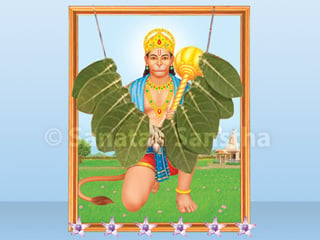
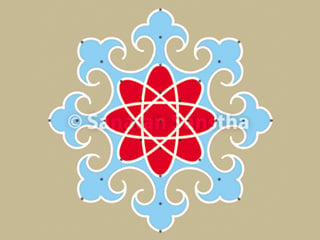 Rangolis that attract and emit Hanuman Principle
Rangolis that attract and emit Hanuman Principle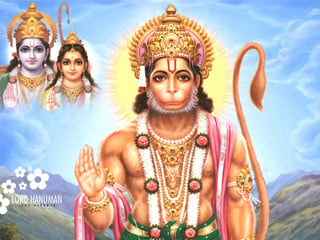 Hanuman ko tel, sindur, ruike patte arpan kyon kiya jata hai? (Hindi Article)
Hanuman ko tel, sindur, ruike patte arpan kyon kiya jata hai? (Hindi Article)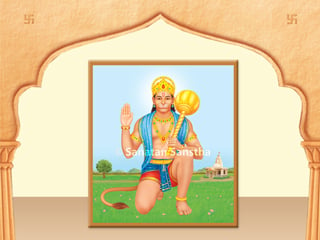 Characteristics of Hanuman - Mission and special features
Characteristics of Hanuman - Mission and special features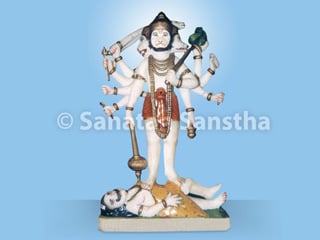 What is the significance of various forms of Hanuman?
What is the significance of various forms of Hanuman?